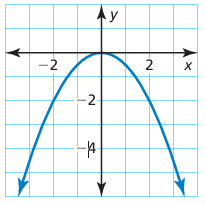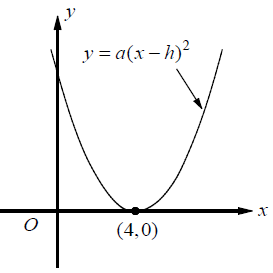FINDING THE EQUATION OF A PARABOLA
The graphical form of a quadratic function will be a parabola. The quadratic equation can be converted into different forms.
- Standard form
- Vertex form
- Factored form
Finding Equation in Standard Form
The quadratic equation which is in the form of
y = ax2 + bx + c
will form a parabola which opens up or opens down.
- If a < 0, then the parabola opens down.
- If a > 0, then the parabola opens up.
Finding Equation in Vertex Form
The quadratic equation which is in the form of
y = a(x - h)2 + k
Here (h, k) is the vertex.
Equations in Factored Form
The factored form of a parabola with zeroes r and s.
y = a (x - r) (x - s)
Equation of the Parabola Passing Through the Given Points
Problem 1 :
Find a quadratic model for each set of values.
(–1, 1), (1, 1), (3, 9)
Solution :
Let the quadratic model be y = ax2 + bx + c
The parabola passes through the given points, so we can apply the points one by one.
It passes through (-1, 1).
1 = a(-1)2 + b(-1) + c
1 = a - b + c
a - b + c = 1 -----------(1)
It passes through (1, 1).
1 = a(1)2 + b(1) + c
1 = a + b + c
a + b + c = 1 -----------(2)
It passes through (3, 9).
9 = a(3)2 + b(3) + c
9 = 9a + 3b + c
9a + 3b + c = 9 -----------(3)
(1) + (2)
a - b + c + a + b + c = 1 + 1
2a + 2c = 2
a + c = 1 ----(4)
Multiply the first equation and subtract (3), we get
3a -
www.cracksat.net
---------------------
Source Url:https://www.cracksat.net/digital/math/question-236-answer-and-explanation.html3b + 3c + 9a + 3b + c = 3+9
12a + 4c = 12 ----(5)
4(4) - (5)
4a + 4c - 12a - 4c = 4 - 12
-8a = -8
a = 1
|
Applying a = 1 in (4), we get 1 + c = 1 c = 0 |
When c = 0 and a = 1 1 + b + 0 = 1 b = 0 |
So, the required equation of parabola is y = x2
Finding Equation in Vertex form
Problem 2 :
Find the quadratic function with the given vertex and point.
Vertex (2, 0) passing through (1, 3).
Solution :
y = a(x - h)2 + k
(h, k) ==> (2, 0)
y = a(x - 2)2 + 0
y = a(x - 2)2 ----(1)
The parabola is passing through the point (1, 3).
3 = a(1 - 2)2
3 = a(-1)2
3 = a
Applying the value of a in (1), we get
y = 3(x - 2)2
Equation of parabola from zeroes or x-intercepts
Problem 3 :
Determine the equation of the parabola whose zeroes are 4 and -5 which passes through (2, -42).
Solution :
Zeroes are 4 and -5.
x = 4 and x = -5
Product of factors :
(x - 4)(x + 5)
Writing it as factored form, we get
y = a (x - 4)(x + 5) ------(1)
The parabola passes through the point (2, -42).
-42 = a (2 - 4)(2 + 5)
-42 = a (-2)(7)
a = 42/14
a = 3
By applying the value of a in (1), we get
y = 3(x - 4)(x + 5)
We can convert this into standard form or vertex form. We can check the answer using graphing calculator.
Problem 4 :
Which function is represented by the graph?

a) y = (1/2) x2 b) y = 2x2 c) y = −(1/2) x2 d) y = −2x
Solution :
Observing the graph, the parabola opens down. The vertex of the parbola is (0, 0).
y = a(x - h)2 + k
Here vertex is at (0, 0).
y = a(x - 0)2 + 0
y = ax2
The parabola passes through the point (-2, -2).
-2 = a(-2)2
-2 = 4a
a = -2/4
a = -1/2
By applying the value of a,
y = (-1/2)x2
So, option c is correct.
Problem 5 :
In the xy-plane above y = a(x - h)2 has one x-intercept at (4, 0). If the y-intercept of the parabola is 9, what is the value of a ?

Solution :
y = a(x - h)2
By applying the point (4, 0), we get
y = a(x - 4)2
The y-intercept of the parabola is 9. Then applying the point (0, 9), we get
9 = a(0 - 4)2
9 = 16a
a = 9/16
So, the value of a is 9/16.
Problem 6 :
Tell whether the function has minimum value or maximum value, then find the value.
i) 5x2 - 20x + 3
ii) -3x2 + 12x - 7
Solution :
i) 5x2 - 20x + 3
y = 5x2 - 20x + 3
Factroing 5,
y = 5[x2 - 4x] + 3
y = 5[(x - 2)2 - 4] + 3
y = 5(x - 2)2 - 20 + 3
y = 5(x - 2)2 - 17
- The parabola opens up.
- It has minimum value
- Minimum is at (2, -17).
ii) -3x2 + 12x - 7
Factroing -3,
y = -3[x2 - 4x] - 7
y = -3[(x - 2)2 - 4] - 7
y = -3(x - 2)2 + 12 - 7
y = -3(x - 2)2 + 5
- The parabola opens up.
- It has maximum value
- Maximum is at (2, 5).
Related pages
Recent Articles
-
Finding Range of Values Inequality Problems
May 21, 24 08:51 PM
Finding Range of Values Inequality Problems -
Solving Two Step Inequality Word Problems
May 21, 24 08:51 AM
Solving Two Step Inequality Word Problems -
Exponential Function Context and Data Modeling
May 20, 24 10:45 PM
Exponential Function Context and Data Modeling